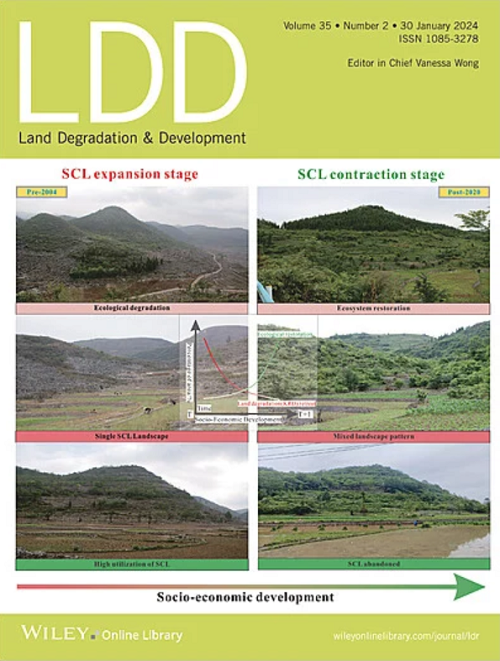Shrub Afforestation Increases Microbial‐Derived Carbon in Arid Regions
IF 3.6
2区 农林科学
Q2 ENVIRONMENTAL SCIENCES
引用次数: 0
Abstract
Soil organic carbon (SOC) primarily originates from microbial and plant‐derived carbon (C). Afforestation activities significantly influence the retention of these C sources. However, in arid regions where SOC is particularly sensitive to external disturbance, the impact of afforestation on microbial‐ and plant‐derived C, and their relative contributions to SOC, remains poorly understood. To address this knowledge gap, we investigated the relative contributions of microbial‐ and plant‐derived C to SOC in three soil layers (0–20 cm, 20–60 cm, and 60–100 cm) by analyzing amino sugars and lignin phenol content. This analysis was conducted following the afforestation of干旱区灌木造林增加微生物碳源
土壤有机碳(SOC)主要来源于微生物和植物碳(C)。造林活动对这些碳源的截留有显著影响。然而,在有机碳对外界干扰特别敏感的干旱地区,造林对微生物和植物源碳的影响以及它们对有机碳的相对贡献仍然知之甚少。为了解决这一知识空白,我们通过分析氨基糖和木质素酚含量,研究了微生物和植物来源的C对3个土层(0-20 cm、20-60 cm和60-100 cm)有机碳的相对贡献。本文对塔克拉玛干沙漠南缘荒漠绿洲过渡带的柽柳造林3、7、10年进行了分析。我们的研究结果表明,造林增加了所有土层的有机碳、营养物质(包括铵态氮、硝态氮和有效磷)以及微生物和植物源碳的水平。其中,微生物来源的碳含量增加了2.15 ~ 2.32倍,植物来源的碳含量增加了41.06% ~ 5.59倍。这导致微生物来源的碳对SOC的贡献增加了28.26%-1.4倍。而植物源碳对0 ~ 60 cm土层有机碳的相对贡献率降低了7.6% ~ 76.38%。值得注意的是,在更深的土层(60-100 cm)中出现了相反的模式,造林使植物源碳对有机碳的贡献增加了2.23-4.31倍。土壤养分是影响植物源性碳积累的主要因素。微生物氮限制的缓解(通过增加的矢量角表示)有助于微生物衍生碳的积累。这些研究结果表明,柽柳造林增强了有机碳的固存,主要是通过微生物衍生碳的积累。这强调了微生物衍生碳对干旱地区造林后有机碳动态的重要性。
本文章由计算机程序翻译,如有差异,请以英文原文为准。
求助全文
约1分钟内获得全文
求助全文
来源期刊

Land Degradation & Development
农林科学-环境科学
CiteScore
7.70
自引率
8.50%
发文量
379
审稿时长
5.5 months
期刊介绍:
Land Degradation & Development is an international journal which seeks to promote rational study of the recognition, monitoring, control and rehabilitation of degradation in terrestrial environments. The journal focuses on:
- what land degradation is;
- what causes land degradation;
- the impacts of land degradation
- the scale of land degradation;
- the history, current status or future trends of land degradation;
- avoidance, mitigation and control of land degradation;
- remedial actions to rehabilitate or restore degraded land;
- sustainable land management.
 求助内容:
求助内容: 应助结果提醒方式:
应助结果提醒方式:


